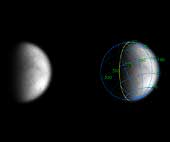|
COMETS EARTH JUPITER KUIPER BELT MARS MERCURY METEORITES NEPTUNE OORT CLOUD PLUTO SATURN SOLAR SYSTEM SPACE SUN URANUS VENUS ORDER PRINTS
PHOTO CATEGORIES SCIENCEVIEWS AMERICAN INDIAN AMPHIBIANS BIRDS BUGS FINE ART FOSSILS THE ISLANDS HISTORICAL PHOTOS MAMMALS OTHER PARKS PLANTS RELIGIOUS REPTILES SCIENCEVIEWS PRINTS
|
Related Document
Download Options
The Cassini orbiter continues its observations of Saturn's mysterious moon Titan, stealing another early peek at the haze-enshrouded surface. Cassini's view of Titan now surpasses Earth-based observations in its ability to show detail. Titan, Saturn's largest moon, is a prime target for the European-built Huygens probe onboard Cassini. Perpetually enshrouded by a hazy atmosphere, scientists believe Titan may harbor methane seas and organic chemicals, possibly like those on the early Earth. Huygens will be the first probe to descend to the surface of a moon of another planet, and is by far the most distant descent of a robotic probe ever attempted on another object in the solar system. The Cassini spacecraft was 29.3 million kilometers (18.2 million miles) from Titan on May 5, 2004, when the image on the left was taken through one of the narrow angle camera's spectral filters specifically designed to penetrate the moon's thick atmosphere. The image scale is 176 kilometers (109 miles) per pixel, an improvement in resolution of 30 percent over the images released on May 6. The image has been magnified 10 times and has been enhanced in contrast to bring out details. The mottled pattern is an artifact of the processing. The larger scale brightness variations are real. No further processing to remove the effects of the overlying atmosphere has been performed. The superimposed coordinate system grid in the accompanying image on the right illustrates the geographical regions of the moon that are illuminated and visible, as well as the orientation of Titan -- north is up and rotated 25 degrees to the left. The yellow curve marks the position of the boundary between day and night on Titan. This image shows about one quarter of Titan's surface, from 180 to 250 degrees west longitude, and overlaps part of the surface shown in the previous Cassini image release PIA05390. |
